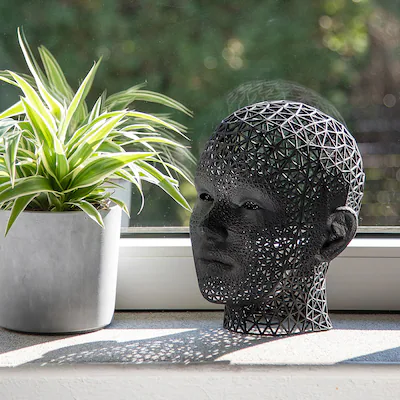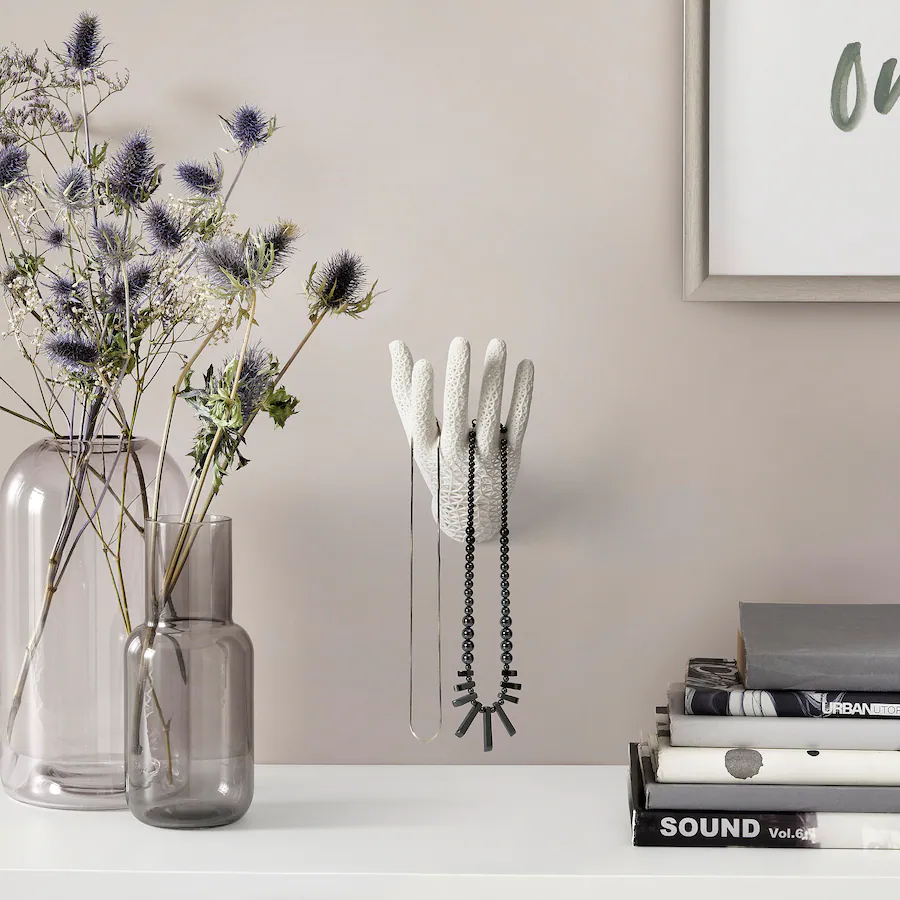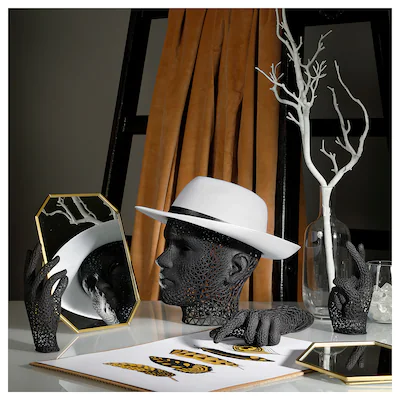Swedish furniture giant IKEA is embarking on another experiment in 3D printing, this time releasing a series of 3D printed décor under a new FLAMTRÄD product line. As reported by 3D Printing Media Network (3DPMN), the collection was the released under the guidance of Olaf Szukałowicz, Project Leader at IKEA, and is now available to customers in Germany.
The series consists of a handful of decorative items that feature a signature lattice design, including hands in various poses (pointing, thumbs up, a heart shape, etc.) as well as a human face. These are produced with selective laser sintering (SLS) using polyamide 12 and are available in black and white options.

The company is still in the process of rolling out the full launch of the FLAMTRÄD product line, with Szukałowicz telling 3DPrint.com, “Sales have not been fully launched and we expect that to happen in January. So, it is still a silent sales start and too early to judge.”
Though 3DPMN hypothesized that DyeMansion may have been responsible for the post-processing and dying of the SLS parts, IKEA was unable to confirm this out of respect for the confidentiality of its suppliers.
However, if we revisit a 2017 announcement from the Swedish furniture firm, we might wonder if the company is relying on the additive manufacturing (AM) operations of Materflow in Finland, with DyeMansion equipment performing the post-processing. This is because the hands being sold by IKEA Germany today look quite similar to those presented by the company and made by Materflow in 2017. Then again, it’s been about four years since that story came out, so perhaps not all went well with its previous partner in the project.

This time around, it may be that IKEA has found out how to get the prices for 3D printed goods low enough so as to mass produce them. With items priced from €29.99 to €49.99, the FLAMTRÄD line may not be as low cost as other IKEA décor, it represents an accessible price point for average consumers interested in displaying art impossible to find in any other mainstream venue.
For those wishing to get their hands on some 3D printed IKEA goods or for those wishing to gauge the growth of consumer 3D printed goods via IKEA’s endeavors, the company does plan to expand into at least one more market in Europe.

“If those test markets are successful, we don’t want to stop there,” Szukałowicz told 3DPrint.com. “There are few AM initiatives taking part in different IKEA organizations. Some are aiming to improve internal operations and some are more customer-facing. They are all at the early stage, so [there is] nothing more to say. To quote our founder, Ingvar Kamprad: ‘Most things remain undone. Glorious future!’”
As DIY enthusiasts have demonstrated repeatedly, IKEA furniture is ripe for hacking with 3D printed parts. From custom swivel mounts for lights to methods for converting a stool into a bike, there are countless ways that makers have modified their Swedish furniture. The company has even encouraged these projects, hosting a competition to produce hacks for its Frekvens speakers.

Perhaps the most inspiring and practical development that occurred with the help of IKEA is called ThisAbles. In partnership with non-profit organizations Milbat and Access Israel, the company has developed models that can be 3D printed for use with IKEA products to make them more useful for people with special needs. These include 3D printable handles for drawers, pieces for stabilizing straws, a mechanism for supporting mouth-held computing devices and more.
IKEA ThisAbles may be the largest corporate effort to support the differently abled with 3D printing. While we’ve seen smaller, individual projects such as 3D printed adapters for gaming controllers, IKEA has seized upon the value of AM to produce custom goods for niche populations. Though it may not be manufacturing these goods, it opens up its products up to a much larger customer base, simultaneously improving access for those with disabilities and access new customers.
It’s now 2022 and things may have aligned just right for IKEA to cost-effectively produce consumer goods on-demand with 3D printing. If the FLAMTRÄD line proves successful and the company does decide to pursue AM more aggressively, we could eventually see things evolve to the point where IKEA is actually able to produce ThisAble-style items themselves or through a partner, opening the door to mass customization. At that point, we would be able to say 3D printing has “made it”.
Images courtesy of IKEA.
Subscribe to Our Email Newsletter
Stay up-to-date on all the latest news from the 3D printing industry and receive information and offers from third party vendors.
You May Also Like
3D Printing Unpeeled: New Arkema Material for HP, Saddle and Macro MEMS
A new Arkema material for MJF is said to reduce costs per part by up to 25% and have an 85% reusability ratio. HP 3D HR PA 12 S has been...
3D Printing News Briefs, January 20, 2024: FDM, LPBF, Underwater 3D Printer, Racing, & More
We’re starting off with a process certification in today’s 3D Printing News Briefs, and then moving on to research about solute trapping, laser powder bed fusion, and then moving on...
3D Printing Webinar and Event Roundup: December 3, 2023
We’ve got plenty of events and webinars coming up for you this week! Quickparts is having a Manufacturing Roadshow, America Makes is holding a Member Town Hall, Stratafest makes two...
Formnext 2023 Day Three: Slam Dunk
I’m high—high on trade show. I’ve met numerous new faces and reconnected with old friends, creating an absolutely wonderful atmosphere. The excitement is palpable over several emerging developments. The high...































